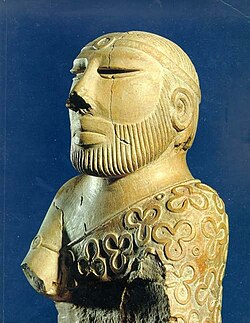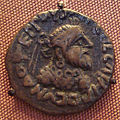Indo-Parthian Kingdom

| History of Pakistan |
|---|
| Timeline |
|
|
|
|
Early modern
|
|
Modern
|
|
History of provinces
|
The Indo-Parthian Kingdom was a Parthian kingdom that existed from 19 to about 226 AD in what is now eastern Iran, most of Pakistan and parts of Afghanistan and northwestern India.[1]
Main rulers
- Gondophares I (c. 19 – 46) Coin
- Gondophares II Sarpedones (first years AD – c. 20 AD)Coin
- Abdagases I (first years AD – mid-1st century AD) Coin
- Gondophares III Gudana, previously Orthagnes (c. 20 AD – 30 AD)
- Gondophares IV Sases, (mid-1st century AD)
- Ubouzanes, (late-1st century AD)
- Pacores (late 1st century AD) Coin
Indo-Parthian Kingdom Media
Portrait of Gondophares, founder of the Indo-Parthian kingdom. He wears a headband, earrings, a necklace, and a cross-over jacket with round decorations.
Ancient Buddhist monastery Takht-i-Bahi (a UNESCO World Heritage Site) constructed by the Indo-Parthians in Khyber Pakhtunkhwa, Pakistan.
The Hellenistic temple with Ionic columns at Jandial, Taxila, Khyber Pakhtunkhwa, Pakistan. It is usually interpreted as a Zoroastrian fire temple from the period of the Indo-Parthians.
Devotees at Zoroastrian fire-altar.
Gandhara Buddhist reliquary with content, including Indo-Parthian coins. 1st century AD.
Related pages
References
- ↑ Gazerani 2015, p. 26.
- ↑ Abraham, George (2020-12-28). Lanterns on the Lanes: Lit for Life…. Notion Press. ISBN 978-1-64899-659-7.
King Gondophares I thus founded the Indo-Parthian Empire with his capital at Taxila, where a number of Parthian or Pahlava monuments such as the remains of the Zoroastrian Fire Temple at Jandial have been found.
Sources
- Bosworth, Clifford Edmund (1997). "Sīstān". The Encyclopedia of Islam, New Edition, Volume IX: San–Sze. Leiden, and New York: BRILL. pp. 681–685. ISBN 9789004082656.
- Schmitt, R. (1995). "DRANGIANA". Encyclopaedia Iranica, Vol. II, Fasc. 5. pp. 534–537.
- Ellerbrock, Uwe (2021). The Parthians: The Forgotten Empire. Routledge.
- Frye, Richard Nelson (1984). The History of Ancient Iran. C.H.Beck. pp. 1–411. ISBN 9783406093975.
The history of ancient iran.
- Gazerani, Saghi (2015). The Sistani Cycle of Epics and Iran's National History: On the Margins of Historiography. BRILL. pp. 1–250. ISBN 9789004282964.
- Bivar, A. D. H. (2002). "GONDOPHARES". Encyclopaedia Iranica, Vol. XI, Fasc. 2. pp. 135–136.
- Olbrycht, Marek Jan (2016). "Dynastic Connections in the Arsacid Empire and the Origins of the House of Sāsān". In Curtis, Vesta Sarkhosh; Pendleton, Elizabeth J.; Alram, Michael; Daryaee, Touraj (eds.). The Parthian and Early Sasanian Empires: Adaptation and Expansion. Oxbow Books. ISBN 9781785702082.
- Rezakhani, Khodadad (2017). ReOrienting the Sasanians: East Iran in Late Antiquity. Edinburgh University Press. pp. 1–256. ISBN 9781474400305.
Other websites
| Wikimedia Commons has media related to Lua error in Module:Commons_link at line 62: attempt to index field 'wikibase' (a nil value).. |










